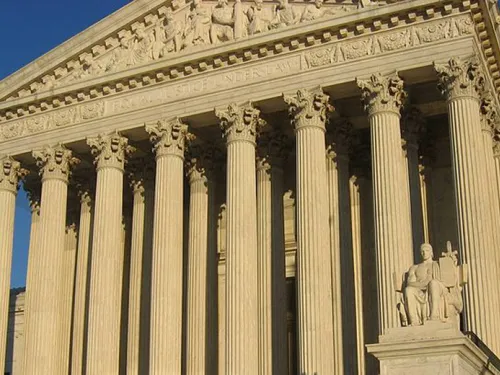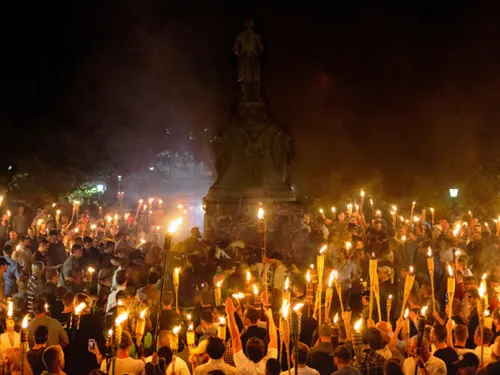Related Items

By Mark Pitcavage, Senior Research Fellow, ADL Center on Extremism
You may have noticed a lot of people are angry at the government these days. The government has certainly noticed.
The FBI and DHS have issued warnings about growing threats against government and law enforcement officials. The IRS has announced a security review of its offices around the country. The U.S. Capitol police reported nearly 10,000 threats against members of Congress during the past year.
Countless other government employees have learned what it’s like to be subjected to angry threats: public health officials, elections officials, school boards—even librarians.
We’ve seen more than mere threats, too, such as the recent attempted attack by a right-wing extremist against the Cincinnati FBI field office. The attacker unsuccessfully tried to get through security with an AR-15. After fleeing, he died in a subsequent standoff with police.
Some officials have described these threats as unprecedented—certainly a measure of their concern. Of course, the United States has had a long history of anti-government anger dating back to the American Revolution. Both left and right have risen in anger against the government at different times.
Is this recent eruption different? Answering that question requires us to revisit previous surges of right-wing anti-government anger.
There have been two spikes of such anger in recent decades. The first emerged in the mid-1990s, when the mainstream right stoked anti-government anger as a convenient way to mobilize conservatives after Bill Clinton’s election ended twelve years of Republican rule. It’s no coincidence right-wing talk radio found its footing during those years. In 1995, the National Rifle Association even labeled federal law enforcement officers as “jack-booted thugs”—causing former president George H. W. Bush to publicly resign.
The far right seethed with even more hostility, enraged by federal gun control laws such as the Brady Law and the Assault Weapons Ban and by the deadly and controversial standoffs at Ruby Ridge, Idaho, and Waco, Texas. The anti-government militia movement arose in response, while other right-wing extremists such as sovereign citizens and white supremacists also surged in popularity.
That anger manifested itself tragically in the April 1995 bombing of the Murrah Federal Building in Oklahoma City and in numerous other terrorist plots and attacks. Not until the decade ended did far right violence die down.
The second surge of anti-government anger began in 2008-09 with the mortgage crisis and Great Recession, increasing after the election of Barack Obama, another Democratic president who followed years of a Republican administration—and the first Black president as well.
My colleague Marilyn Mayo and I documented this anger in a 2009 report titled “Rage Grows in America.” On the mainstream right, this anger propelled the rise of the Tea Party, half-grassroots, half-manufactured movement designed to stoke anger at the federal government and Obama himself. It included a disturbing racist and xenophobic component exemplified by the so-called “birthers” spreading baseless conspiracy theories that Obama had not been born in the United States.
The far right also embraced birtherism, but additionally linked Obama to the “New World Order” conspiracies that motivated the militia movement. That movement had declined during the 2000s but now experienced a major revival that spawned hundreds of new groups. The sovereign citizen movement also surged strongly.
This anti-government extremist surge generated another rise in right-wing violence. In 2010, for example, members of the Alaska Peacemakers Militia plotted to kill federal and state judges and law enforcement; that same year, Andrew Joseph Stack even flew an airplane into a building that housed IRS offices in Austin, Texas.
Is the current wave of anti-government anger different? To be sure, it too follows the election of a Democratic president. Moreover, some of the anger—such as that against the IRS—has been traditional government-bashing largely for political purposes. And, of course, there are far more channels for viral amplification of this current anger thanks to popular digital platforms, some of which have only emerged within the past decade.
But what makes the current situation new in terms of the source of the anger is former president Donald Trump. So many of the recent threats have emanated, directly or indirectly, as a result of the rhetoric and actions of one person: Trump.
Previous waves of anger have no analogue to Trump. Even before he was elected president in 2016, Trump stirred anger among his followers by claiming vote rigging. In 2020, as he sought re-election, Trump took this tactic to a new level, assiduously pre-delegitimizing the upcoming November election and priming the cynicism and anger of supporters through constant claims of voter fraud. After losing, Trump loudly proclaimed that this non-existent fraud had denied him his real victory. Those false claims, echoed by lieutenants and followers, incited the violent January 2021 storming of the U.S. Capitol by thousands of fanatic Trump supporters intent on keeping Trump in office.
This truly was unprecedented. The “Stop the Steal” rhetoric of Trump and his lieutenants caused millions of Americans to distrust their own electoral system, one that had long been the envy of the world.
Today, a year and a half later, Trump continues election-denying while launching new attacks against the FBI, the Justice Department, and other institutions as an angry response to the various civil and criminal investigations looking into him. The threats against the FBI, including the attack in Cincinnati, did not take place in a vacuum. The cause and effects are clear.
Unprecedented, indeed: a former president taking a sledgehammer to institutions at the heart of our laws and democracy. Moreover, he is succeeding in weakening those foundations. But the damage is not just the work of one man, however demagogic and powerful. As is always the case with actual and would-be autocrats, the cowed or cynical silence of too many others in power is what allows the sledgehammer to strike with full force.
This damage is something all Americans should fear.
Mark Pitcavage is a historian and Senior Research Fellow at the ADL Center on Extremism.









